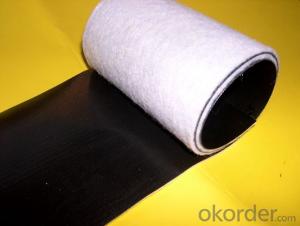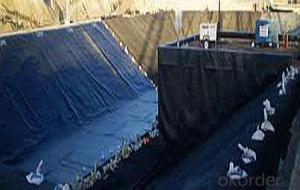Geotextil Tejido 2400 Ficha Técnica Linear Low-Density Polyethylene Geomembrane for Reserve Water
- Loading Port:
- China main port
- Payment Terms:
- TT OR LC
- Min Order Qty:
- 1000 m²
- Supply Capability:
- 10000000 m²/month
OKorder Service Pledge
OKorder Financial Service
You Might Also Like
Specification


HDPE Anti-permeable film Feature
Good mechanical properties, high tear strength, deformation and adaptable, puncture resistance,
anti-aging, anti-ultraviolet-resistant,
Anti oil and salt, pH, anti-corrosion, high temperature-resistant, non-toxic, long service life. water,
drainage, seepage, the good effect of moisture, width, thickness of the full range of specifications
and low cost, simple construction.
HDPE Anti-permeable film Application
1) Environmental protection, sanitation (such as solid waste landfills, sewage treatment plants, power plants Chi-conditioning, industrial, hospital solid waste, etc.) .
2) Water (such as rivers, lakes and reservoirs of the anti-dam, plugging, reinforcement of the canal seepage, the vertical wall of the heart, slope protection, etc.).
3) Municipal Engineering (subway, on the ground floor of the building, planted roof, the roof garden of anti-seepage, sewage pipes lining, etc.).
Our Service
Quality assurance
1.On a regular basis or as per your request,we entrust national testing agencies to conduct quality inspections
2. Strictly in accordance with the ISO9001-2008 international quality system standard,we monitor and manage the whole process throughout production,quality testing,and measurement to ensure product quality
3. For quality-related construction delay or substandard construction(except for damage or losses due to customer’s responsibility or irresistible natural disasters),we have refunding,replacement,and repair services.We will respond to customers’ feedbacks on quality issues within 24 hours.
Q: What kind of payments does jenor support?
A: T/T, L/C, Cash are accepted.
Q: Do you charge for the samples?
A: Accordeing to our company policy, the samples are free, we only charge the freight fee. And we will return the freight fee during the next order.
Q: Can you produce according to customers' design?
A: Sure, we are professional manufacturer, OEM and ODM are both welcome.
Q: Do you have other products?
A: Yes, please check the pictures:
Packaging & Shipping
Packing: PLASTIC FILM INSIDE, AND WOVEN BAG OUTSIDE
Shipping: About 15 days after receipt the deposit
geotextile fabric
permeability,filtration,easy for construction
ISO and CE certificate
Good quality and competitive price
- Q: What is geotextile cloth?
- Geogrid, geotextile, geomembrane manufacturers, specializing in the production
- Q: Can geotextiles be used in erosion control in coastal bluff stabilization?
- Yes, geotextiles can be used in erosion control in coastal bluff stabilization. Geotextiles are commonly employed to reinforce and stabilize slopes, including coastal bluffs, by preventing soil erosion and promoting vegetation growth. They are effective in reducing surface runoff and controlling sediment movement, thus providing stability to coastal bluffs and preventing further erosion.
- Q: What are the different factors to consider for geotextile selection in agricultural applications?
- When selecting geotextiles for agricultural applications, several factors need to be considered. These factors include the type and level of soil erosion, the desired drainage and filtration requirements, the expected load and stress levels on the geotextile, the potential for chemical exposure, the climate and weather conditions, and the longevity and durability needed for the specific agricultural application.
- Q: How do geotextiles contribute to soil filtration?
- Geotextiles contribute to soil filtration by acting as a barrier that allows water to pass through while retaining soil particles. They enhance the filtration process by preventing the migration of fine particles and protecting the underlying soil from erosion.
- Q: How are geotextiles used in civil engineering?
- Geotextiles are used in civil engineering for various purposes such as soil stabilization, drainage, filtration, erosion control, and reinforcement. They are often employed to prevent soil erosion, improve soil strength, and enhance the overall stability of civil engineering structures like roads, embankments, and retaining walls. Geotextiles are also used in the construction of landfills, dams, canals, and coastal protection systems to provide effective filtration and drainage properties.
- Q: Do you need to suture the lower geotextile of composite geomembrane?
- Under normal circumstances without suture (stretch, overlap to a piece like), just the geomembrane welding, the top layer of geotextile with a hand sewing machine sewing can be geotextile as a protective layer of geomembrane, to protect the impermeable layer In order to reduce the UV radiation, increase the anti-aging performance, it is best to use the laying method of laying.In the construction, the first use of smaller diameter sand or clay to find the base surface, and then laying, Too tight, buried at both ends of the soil part of the corrugated, and finally in the shop on the two cloth a film with fine sand or clay shop layer of 10cm over the layer. Puzzle 20-30cm stone (or concrete prefabricated block) For the protection of the layer.When the construction, should try to avoid the stone directly hit on the best side of the film side of the protective layer of the construction of the two cloth a film and the surrounding structure should be connected with expansion bolts and steel plate pressure bar anchor, The connection part to brush the emulsion asphalt (2mm thick) bonding, to prevent the occurrence of leakage. Construction joint processing is a key process, a direct impact on seepage effect. General seam way: ① lap: lap width Should be greater than 15cm; ② heat welding: suitable for slightly thick geomembrane substrate, weld lap width of not less than 5C M
- Q: What are the factors to consider when selecting a geotextile for a specific application?
- When selecting a geotextile for a specific application, there are several factors to consider. Firstly, the intended function of the geotextile needs to be evaluated. This includes determining whether it will be used for separation, filtration, reinforcement, or drainage purposes. Secondly, the site conditions and environmental factors such as soil type, climate, and potential chemical exposure must be taken into account. The required strength, durability, and longevity of the geotextile should also be considered. Additionally, the cost-effectiveness and availability of the specific geotextile should be assessed. Finally, the installation and maintenance requirements of the geotextile need to be evaluated to ensure proper implementation and long-term performance.
- Q: Geotextile seepage seams how to deal with
- Hand wrap the sewing machine and seal it.
- Q: Can geotextiles be used in erosion control blankets?
- Yes, geotextiles can be used in erosion control blankets. Geotextiles are often used as a material in erosion control blankets to provide stabilization and reinforcement against soil erosion. They help to prevent sediment runoff and promote vegetation growth, making them effective in erosion control applications.
- Q: Are geotextiles resistant to hydraulic shear stress?
- Yes, geotextiles are generally resistant to hydraulic shear stress. They have a high tensile strength and are designed to withstand the forces exerted by flowing water or other hydraulic conditions, making them effective in erosion control and soil stabilization applications.
Send your message to us
Geotextil Tejido 2400 Ficha Técnica Linear Low-Density Polyethylene Geomembrane for Reserve Water
- Loading Port:
- China main port
- Payment Terms:
- TT OR LC
- Min Order Qty:
- 1000 m²
- Supply Capability:
- 10000000 m²/month
OKorder Service Pledge
OKorder Financial Service
Similar products
Hot products
Hot Searches
Related keywords
































